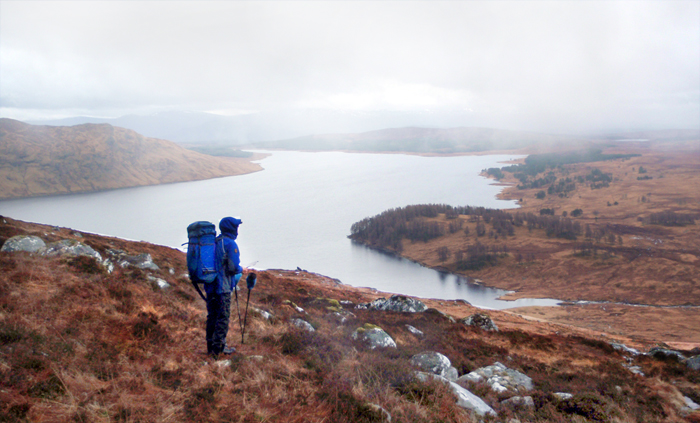Chasing the rain: Life as a product tester

So where will the worst weather be? Helen, my co designer and I debate the mountain location for our monthly field testing get together. We plumb for the Highlands as our best bet.Strange as it may seem, the forecasts for bad weather are not as reliable as you might imagine. Chasing the rain often results in some of the finest days on the hill. Thus it is as we leave Corrour station and head east along Loch Ossian, the clouds are high and precipitation uncertain. Not too disappointed at this stage, as we have three days around the Ben Alder area to check out our latest prototype designs, fabrics and treatments. We will spend two nights out in bothies and try to cover as much ground as possible. There is no special testing activity involved. We just do what our customers do – explore wild country – and test our products doing the relevant activity….walk…scramble …climb.
The main difference is that we spend time recording the weather conditions, and garment performance. When we return home our activity is documented and reported to the relevant development teams at Nikwax and Páramo. So we carry two essential tools. The camera, and a weather tracker. The pictures often reveal the features that are performing as required, and those which need attention. But for every picture we can link the precise weather conditions, temperature, wind strength, windchill, humidity and altitude. A click of a button makes the recording, and the data can be downloaded on return. The precipitation can also be charted if we take enough shots of the weather changes, and co-ordinate the tracker recordings. Our intention is to be able to define precisely what each garment can do and justify the claims we make for its performance. The two of us discuss continuously the pros and cons of the ideas we are putting to the test, but at the end of a wet day the evidence is clear, and any subjective desire for a positive result often discounted!
So we reach the bothy at Culra after a pleasant dry wander through the glens, pondering such things as male female differences in body temperature control, how best to secure snow cuffs under boots. We identify problems, and argue the best ways to experiment solutions….but still no rain!
The following day on the summit of Ben Alder things have improved. Westerly fresh breeze, minus 5.1.C. windchill, 97.9% humidity with heavy showers that merge to give us four hours of solid wet. I set off in the wrong direction from the summit, and we have to trudge back up and take a proper bearing. So much for my local knowledge. We put on our insulated sleeves to give us more time to do the job properly. It still feels counter intuitive to put dry quilted garments on over wet shell jackets, but the Nikwax insulator fill covered with windproof fabric is incredibly effective, even when it looks wet. In these conditions the overlayering strategy is the only effective way to conserve heat. Less chat then as we lose height to arrive at Ben Alder Cottage. It appears suddenly below us as the cloud thins. Plenty of inspection and photos of our wet looking attire when we arrive but…. dry bodies. Brews, food, sleep and once more our luck is in….heavy drizzle, low cloud, another wet day in prospect. More careful with our navigation, we pick our way over Sgorr Choinnich and Carn Dearg. The routine of navigating and recording is absorbing. We share the pleasure of being in such wild country, together with a hint of shared success- our latest hood designs have proved very effective on this trip. We are already thinking of the refinements we will make back in the workshop. It is dark when we reach the shelter on the platform at Corrour. It is hard to imagine a train will arrive in such a desolate location. Helen is already writing notes on a scrap of paper. I make a brew and contemplate with satisfaction our time on the hill.
Written by Greg Care, Páramo designer and Nikwax fabric tester

Leave a Reply